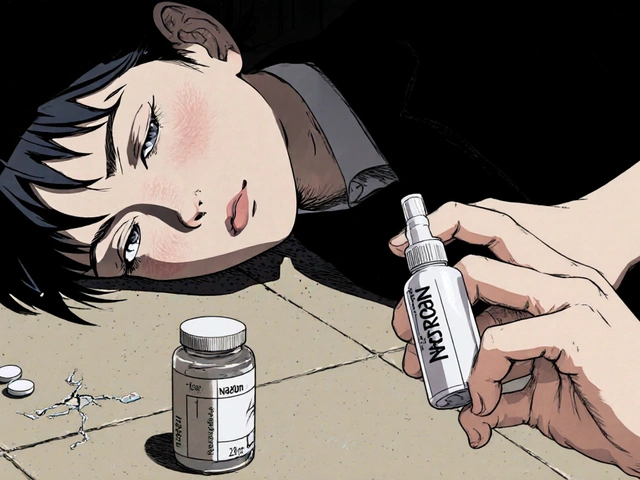For people with severe asthma, standard inhalers often aren’t enough. Even with high-dose steroids and long-acting bronchodilators, they still wake up gasping, end up in the ER, or rely on monthly oral steroids that wreck their bones, blood sugar, and mood. That’s where biologics come in-not as magic pills, but as precise tools that shut down specific parts of the immune system causing the flare-ups.
What Are Biologics, Really?
Biologics aren’t made in a lab like regular pills. They’re proteins grown in living cells-usually from bacteria or mouse tissue-then tweaked to target one exact molecule in your body. Think of them like guided missiles for inflammation. Instead of blasting your whole immune system (like steroids do), they zero in on just the troublemakers.
Two main types are used for severe asthma: anti-IgE and anti-IL-5. Omalizumab (Xolair) is the original anti-IgE drug, approved back in 2003. Anti-IL-5 drugs include mepolizumab (Nucala), reslizumab (Cinqair), and benralizumab (Fasenra). Each works differently, but all aim to stop the chain reaction that turns mild irritation into full-blown asthma attacks.
How Anti-IgE Works: Targeting Allergy’s Root
If your asthma flares up every time you’re around dust mites, pets, or pollen, you likely have allergic asthma. That’s where IgE-the antibody your body overproduces in response to allergens-comes in. IgE sticks to mast cells and basophils, and when it meets your allergen again, those cells explode with histamine and other inflammatory chemicals. That’s what causes wheezing, coughing, and chest tightness.
Omalizumab binds to free IgE in your blood before it can attach to those cells. No IgE binding = no explosion = fewer attacks. It’s not a cure. It doesn’t stop allergies. But it takes the fuel out of the fire.
To qualify, you need to be at least 6 years old, have confirmed allergies (through skin or blood tests), and have serum IgE levels between 30 and 1500 IU/mL. Dosing is based on your weight and IgE level-every 2 to 4 weeks, usually with an auto-injector. Many patients start noticing fewer symptoms after 12 to 16 weeks. The INNOVATE trial showed a 50% drop in exacerbations for those who fit the profile.
How Anti-IL-5 Works: Stopping Eosinophils in Their Tracks
Not all severe asthma is allergic. Some people have high levels of eosinophils-white blood cells that swarm the airways and cause swelling, mucus, and narrowing. This is called eosinophilic asthma. Anti-IL-5 drugs cut off the signal that tells the body to make more of these cells.
Mepolizumab and reslizumab bind directly to IL-5, the protein that tells bone marrow to produce eosinophils. Benralizumab goes further: it attaches to the IL-5 receptor on the eosinophils themselves, triggering their self-destruction. Within 24 hours, benralizumab can wipe out nearly all circulating eosinophils. Mepolizumab takes longer-weeks to reduce counts.
You’re a candidate if your blood eosinophil count is 150 cells/μL or higher in the past year (or 300+ if you’ve had recent flare-ups). Mepolizumab and benralizumab are injected every 4 weeks; benralizumab switches to every 8 weeks after the first three doses. Reslizumab requires an IV infusion every 4 weeks, which means a clinic visit each time.
In the MENSA trial, mepolizumab cut exacerbations by 52%. Benralizumab’s ZONDA trial showed a 51% reduction. For many, this means going from 3-4 ER trips a year to zero.

Anti-IgE vs. Anti-IL-5: Which One Fits You?
There’s no one-size-fits-all. The choice comes down to your asthma type and biomarkers.
| Feature | Anti-IgE (Omalizumab) | Anti-IL-5 (Mepolizumab, Benralizumab) |
|---|---|---|
| Target | Immunoglobulin E (IgE) | Interleukin-5 or its receptor |
| Best for | Allergic asthma with confirmed allergens | Eosinophilic asthma, regardless of allergy status |
| Required biomarker | Serum IgE: 30-1500 IU/mL | Blood eosinophils: ≥150-300 cells/μL |
| Dosing | Every 2-4 weeks, subcutaneous | Every 4 weeks (every 8 after 3 doses for benralizumab) |
| Administration | Auto-injector or clinic | Auto-injector (except reslizumab: IV) |
| Time to effect | 12-16 weeks | 4-12 weeks |
| Reduction in exacerbations | ~50% | 51-52% |
| Oral steroid reduction | Up to 50% | Up to 60% |
Some patients with both allergic and eosinophilic features may respond to either. But if you’re allergic but have low eosinophils, anti-IgE is your best shot. If you’re not allergic at all but keep having flare-ups with high eosinophils, anti-IL-5 is the way to go.
Real Results: What Patients Actually Experience
It’s not just trial numbers. Real people report life changes.
One patient on Reddit, u/AsthmaWarrior2020, went from 3-4 ER visits a year to none after six months on mepolizumab. They dropped their daily prednisone from 10 mg to occasional bursts. Another, u/BreathlessInSeattle, had to stop benralizumab after three doses because of severe joint pain-even though their asthma improved.
Side effects are usually mild: sore throat, headache, or redness at the injection site. About 1 in 10 people get these. Anaphylaxis is rare-about 1 in 1,000 doses-but higher if you’ve had severe allergies before. That’s why the first few doses are given in a clinic, with observation.
Benefits don’t come overnight. Some feel better in 4 weeks. Others wait 4 months. Patience is part of the process. But for those who respond, the payoff is huge: fewer hospital stays, no more monthly steroids, and the ability to play with kids, hike, or sleep through the night without a nebulizer.

Who Gets Left Out?
Biologics aren’t for everyone. About 30-40% of people who start them don’t respond meaningfully. Why? Because asthma isn’t one disease. It’s a collection of different inflammatory patterns. If your asthma isn’t driven by IgE or eosinophils, these drugs won’t help.
That’s why testing matters. Before starting, your doctor should check:
- How well you’re using your inhalers (many think they’re on track, but they’re not)
- Your asthma control score (like the Asthma Control Test)
- Your blood eosinophil count
- Your serum IgE level
- Your exhaled nitric oxide (FeNO), which shows airway inflammation
If you’re still having attacks despite all that, and your biomarkers don’t match the drug’s target, biologics won’t fix it. They’re precision tools, not universal fixes.
Cost, Access, and the Road Ahead
These drugs cost $25,000 to $40,000 a year. Insurance requires prior authorization-often taking 2 to 3 weeks. Some patients wait months. Manufacturer programs help with co-pays, but gaps still exist.
Access is better in the U.S. than in Europe or Asia. In Australia, access is improving but still limited to specialist asthma clinics. Only about 1-2% of eligible patients get biologics globally. Cost and lack of testing infrastructure are the biggest barriers.
But things are changing. Tezepelumab (Tezspire), approved in 2021, works upstream by blocking TSLP-a signal that kicks off multiple inflammation pathways. It works even if your eosinophils are low. That’s a big deal. And newer versions are in trials: some with dosing every 6 months. Oral options are also being tested, though none are approved yet.
The future isn’t just more drugs. It’s smarter matching. Blood tests, AI-driven algorithms, and better biomarkers will help doctors pick the right drug for the right person-faster, with fewer trial-and-error cycles.
Final Thoughts: Biologics Aren’t a Cure, But They’re a Game Changer
Biologics haven’t replaced inhalers. You still need them. They haven’t made asthma disappear. But for people who’ve been stuck in a cycle of flare-ups, steroids, and hospital visits, these drugs offer something rare: control.
They don’t work for everyone. They’re expensive. They require commitment. But for those who fit the profile, they’re not just another medication-they’re a return to normal life. No more panic attacks at 3 a.m. No more missing work. No more dreading the change of seasons.
If you’ve tried everything and still struggle to breathe, ask your specialist about biomarker testing. It might not change everything. But it might change your life.
Are biologics a cure for severe asthma?
No, biologics are not a cure. They’re add-on therapies that reduce inflammation driven by specific immune pathways. You still need to use your inhalers and avoid triggers. But they can dramatically reduce flare-ups, hospital visits, and steroid use.
How long before I see results from a biologic?
Most people start noticing improvements between 4 and 16 weeks. Some feel better sooner, especially with benralizumab. Others take longer. Don’t stop treatment if you don’t see results right away-give it at least 3 to 6 months.
Can I stop my inhalers if I start a biologic?
No. Biologics work alongside your regular asthma medications. Stopping your inhalers can lead to dangerous flare-ups. Your doctor may reduce your steroid dose over time, but never stop your controller inhalers without guidance.
Do biologics cause weight gain or mood changes?
Unlike oral steroids, biologics don’t typically cause weight gain, mood swings, or diabetes. Their side effects are mostly local-injection site reactions-or mild, like headaches. Serious side effects are rare.
Is it safe to get biologics if I have other health conditions?
Generally yes, but your doctor will review your full health history. Biologics are avoided if you have active parasitic infections, certain cancers, or a history of severe allergic reactions to the drug itself. If you have chronic sinusitis, eczema, or nasal polyps, biologics may actually help those too.
What happens if I miss a dose?
If you miss one dose, give it as soon as you remember. Then go back to your regular schedule. Don’t double up. Missing one dose won’t undo progress, but frequent missed doses can reduce effectiveness. Talk to your clinic if you’re having trouble keeping up with injections.
Can children use these biologics?
Yes. Omalizumab is approved for children 6 and older. Mepolizumab and benralizumab are approved for ages 6 and 12+, respectively. Pediatric use requires careful monitoring, but many families report improved school attendance and fewer missed activities after starting treatment.
Will my insurance cover this?
Most insurers cover biologics for severe asthma, but only after you’ve tried and failed on standard treatments. You’ll need documentation of exacerbations, biomarker results, and proof of inhaler use. Prior authorization can take 2-3 weeks. Manufacturer support programs can help with out-of-pocket costs.





Jennifer Bedrosian
November 11, 2025 AT 05:38Okay but like… I’ve been on Xolair for 2 years and honestly? It’s the only thing that let me sleep without a nebulizer. My kid used to cry because I was wheezing at night. Now we watch Netflix like normal people. No drama. No steroids. Just breathing. Thank you for writing this.
Lashonda Rene
November 12, 2025 AT 15:58i know right like i had no idea biologics were even a thing until my doc mentioned it and i was like wait you mean i dont have to be in the er every other month? i thought asthma was just something you lived with forever. turns out my body was just making too many eosinophils and no one told me that was a thing. now i get shots every 4 weeks and i went from missing work 3x a month to zero. its not magic but its like someone finally turned off the alarm that was going off in my lungs. also i spelled eosinophil wrong like 7 times before i got it right lol
Andy Slack
November 13, 2025 AT 11:45Just want to say this is one of the clearest explanations I’ve ever read on asthma biologics. No fluff. No jargon overload. Just straight facts with real impact. If you’re struggling and haven’t been tested for biomarkers yet - do it. Your future self will thank you. 💪
Rashmi Mohapatra
November 15, 2025 AT 11:09USA people always think their healthcare is so advanced but here in India we dont even have access to these drugs. My cousin has severe asthma and her doctor says biologics cost more than her house. She still uses nebulizer 5 times a day. This post is nice but its for rich people only. Sad.
Abigail Chrisma
November 16, 2025 AT 21:18Thank you for sharing this so clearly - especially the part about not stopping inhalers. So many people think biologics are a replacement, not a boost. I’ve worked with families where kids were barely going to school because of asthma, and once they got on benralizumab? Suddenly they’re playing soccer, sleeping through the night, and asking for more pancakes. It’s not just medical - it’s emotional freedom. And yes, the cost is insane. But if you’re eligible, fight for it. Advocate. Call your insurer. Write your rep. You’re worth it.
Ankit Yadav
November 17, 2025 AT 08:56Great breakdown. One thing missing: what if you’re allergic AND have high eosinophils? I’m in that gray zone. My doc said I could try either. I went with omalizumab because I hate IVs. Took 14 weeks to feel it but now I’m down to 1 ER visit a year. Also, the joint pain thing is real - I know someone who had to stop benralizumab. Listen to your body. And don’t give up if the first one doesn’t click. There’s more than one key to this lock.
Meghan Rose
November 18, 2025 AT 04:33Ugh I hate how everyone acts like biologics are this miracle cure. My sister tried mepolizumab and it did nothing. She still had to go to the ER. And now she’s stuck with $30k in debt because her insurance denied it after 6 months. And don’t even get me started on the injection site bruising. It’s not ‘life-changing’ for everyone. Stop glorifying it. Not everyone fits the profile. And the ‘just ask your doctor’ advice? That’s useless when your doctor doesn’t even test for FeNO or eosinophils. This whole system is broken.
Steve Phillips
November 19, 2025 AT 01:25Let’s be real - this is the *only* reason why Big Pharma hasn’t killed asthma yet. They’d rather sell you $40,000/year injectables than a $2 pill that actually cures it… which they *could* make… if they wanted to. 😏 The fact that you need a blood test, a 3-week insurance battle, and a PhD in immunology just to get a shot? Pathetic. And don’t get me started on Tezspire - it’s just the same drug with a fancier name and a $50K price tag. Meanwhile, people in developing countries are still using nebulizers powered by hope. This isn’t medicine - it’s performance art for the wealthy. 🤡